Abstract
Bacteria were isolated that could utilize representatives of the following ionic phosphorus-containing breakdown products of organophosphorus pesticides as sole phosphorus sources: dialkyl phosphates, dialkyl phosphorothioates, dialkyl phosphorodithioates, alkyl arylphosphonates, alkyl arylphosphonothioates, and alkyl alkylphosphonates. Utilization of each organophosphorus compound, which was complete for 7 of 12 compounds studied, was confirmed by determination of protein yield from the amount of phosphorus source consumed. This is the first report of the utilization of an ionic dialkyl thiophosphate or dithiophosphate by microorganisms.
Full text
PDF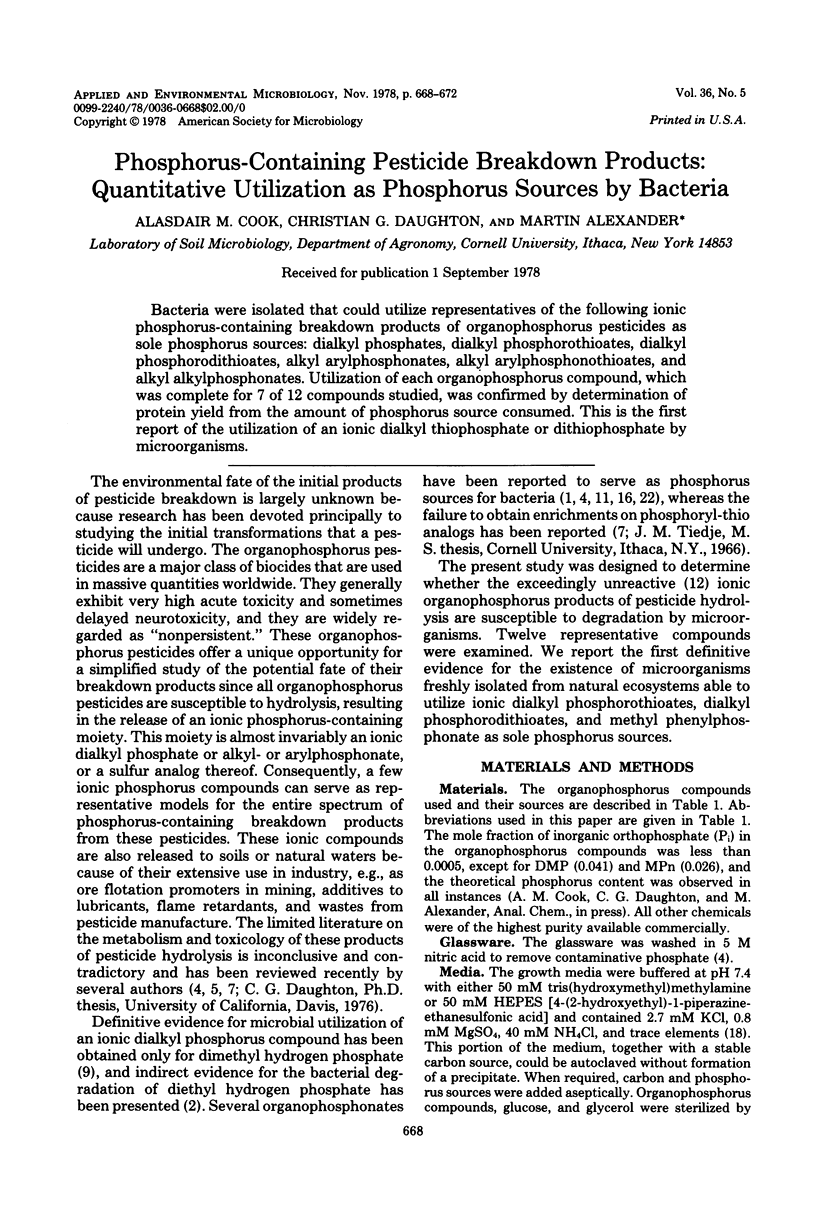
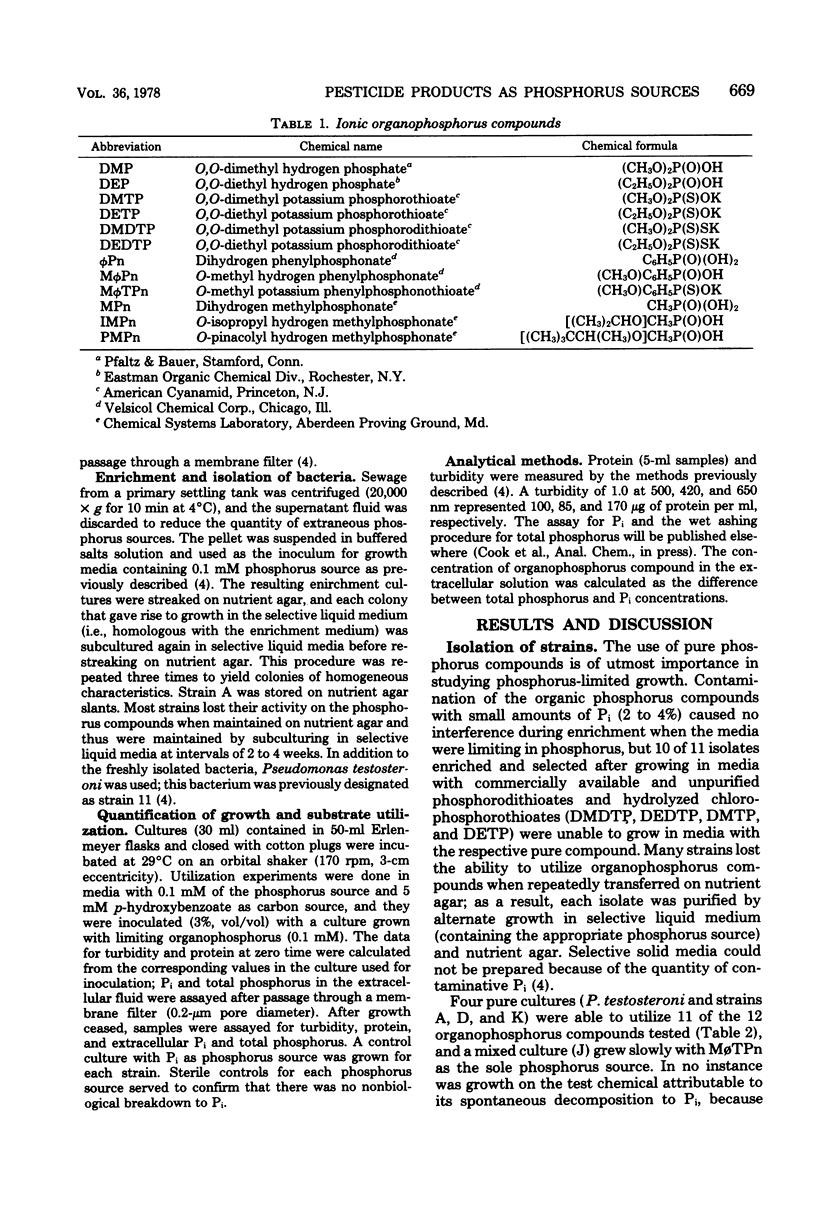
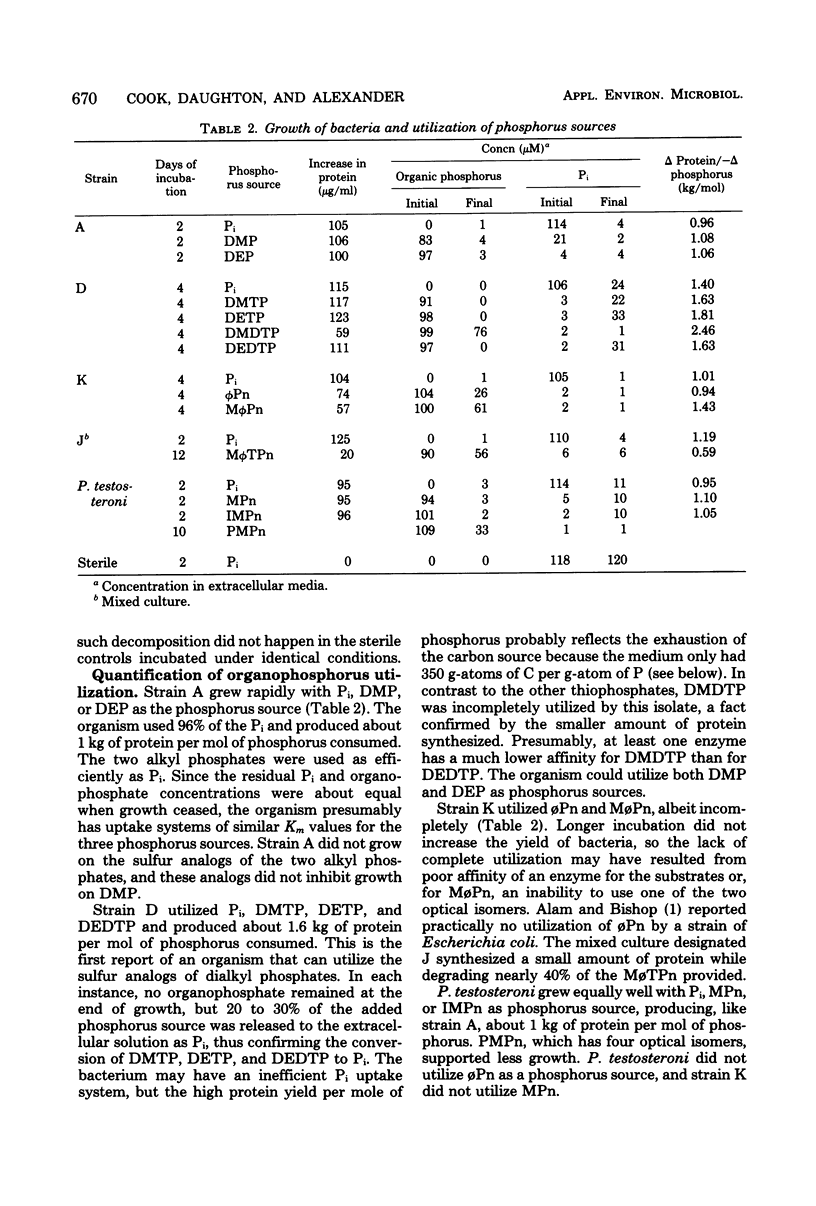
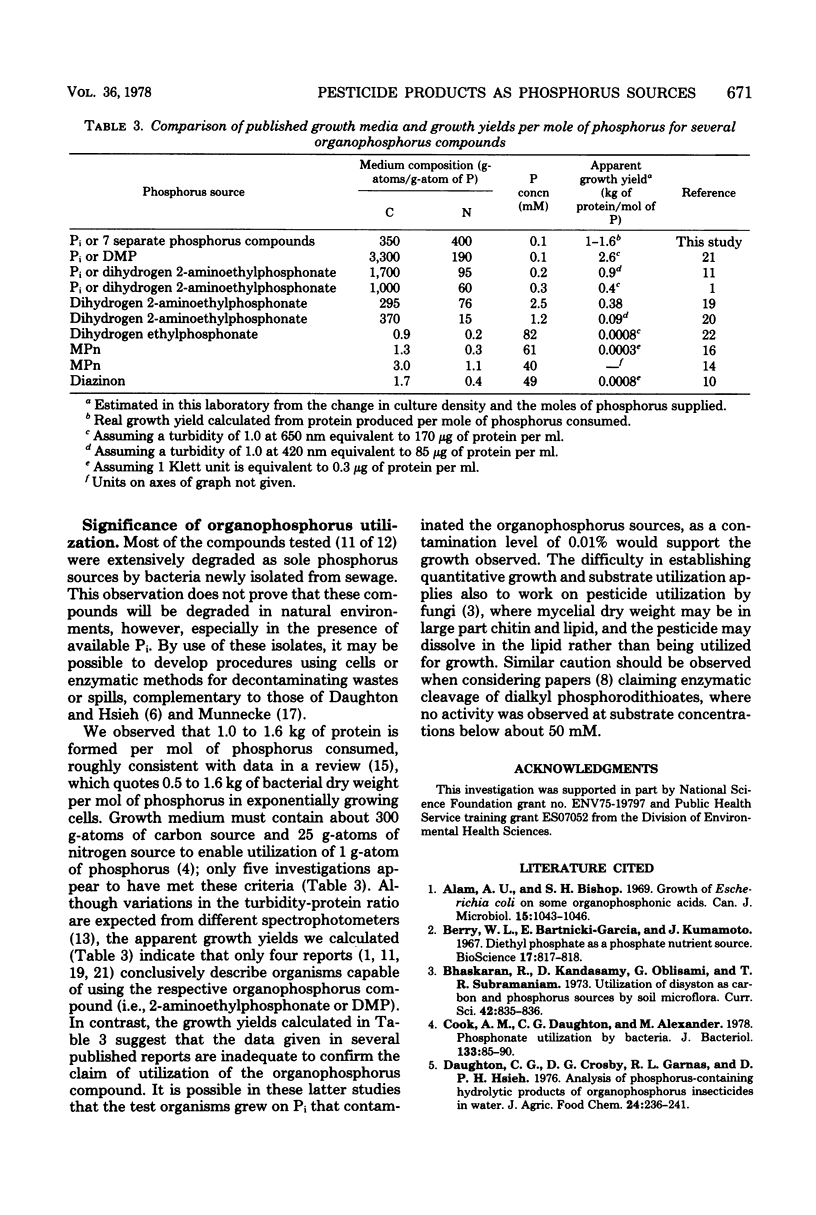
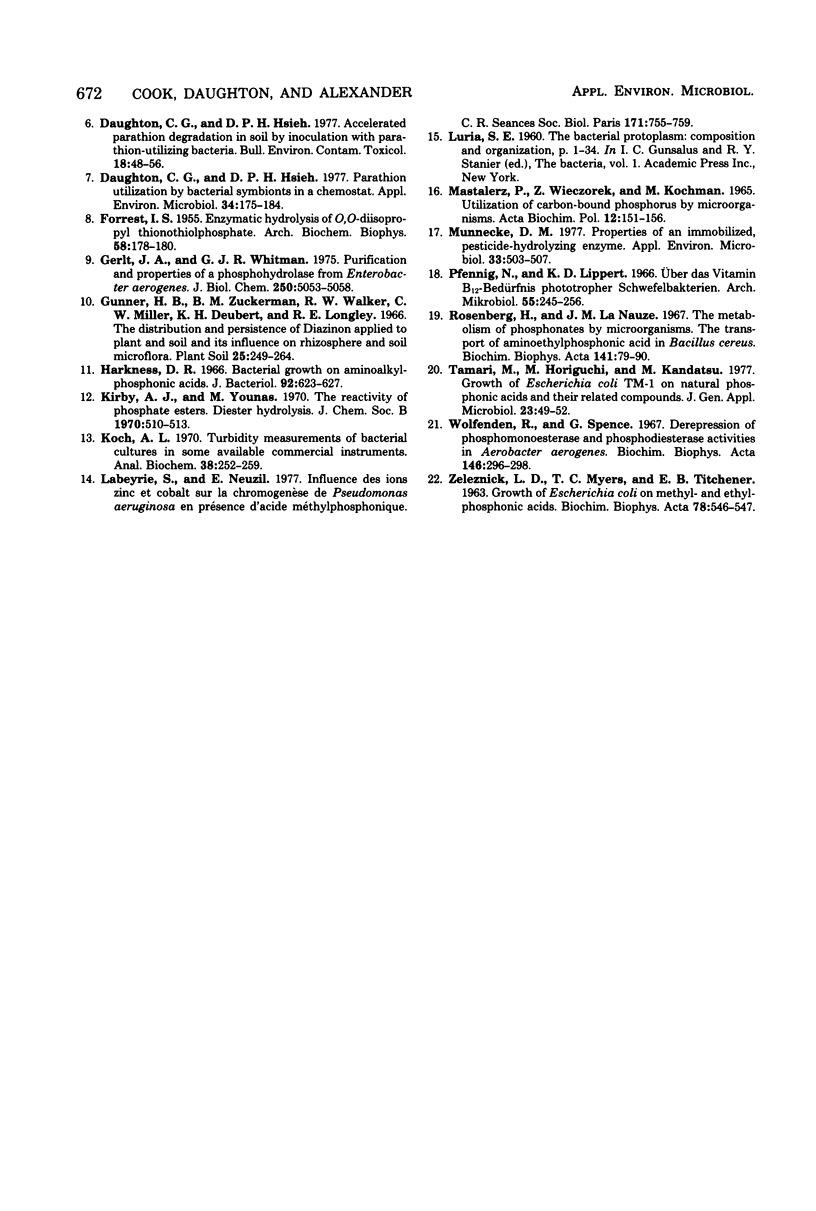
Selected References
These references are in PubMed. This may not be the complete list of references from this article.
- Alam A. U., Bishop S. H. Growth of Escherichia coli on some organophosphonic acids. Can J Microbiol. 1969 Sep;15(9):1043–1046. doi: 10.1139/m69-185. [DOI] [PubMed] [Google Scholar]
- Cook A. M., Daughton C. G., Alexander M. Phosphonate utilization by bacteria. J Bacteriol. 1978 Jan;133(1):85–90. doi: 10.1128/jb.133.1.85-90.1978. [DOI] [PMC free article] [PubMed] [Google Scholar]
- Daughton C. G., Crosby D. G., Garnas R. L., Hsieh D. P. Analysis of phosphorus-containing hydrolytic products of organophosphorus insecticides in water. J Agric Food Chem. 1976 Mar-Apr;24(2):236–241. doi: 10.1021/jf60204a015. [DOI] [PubMed] [Google Scholar]
- Daughton C. G., Hsieh D. P. Accelerated parathion degradation in soil by inoculation with parathion-utilizing bacteria. Bull Environ Contam Toxicol. 1977 Jul;18(1):48–56. doi: 10.1007/BF01686304. [DOI] [PubMed] [Google Scholar]
- Daughton C. G., Hsieh D. P. Parathion utilization by bacterial symbionts in a chemostat. Appl Environ Microbiol. 1977 Aug;34(2):175–184. doi: 10.1128/aem.34.2.175-184.1977. [DOI] [PMC free article] [PubMed] [Google Scholar]
- FORREST I. S. Enzymatic hydrolysis of O, O-diisopropyl thionothiolphosphate. Arch Biochem Biophys. 1955 Sep;58(1):178–180. doi: 10.1016/0003-9861(55)90103-x. [DOI] [PubMed] [Google Scholar]
- Gerlt J. A., Whitman G. J. Purification and properties of a phosphohydrolase from Enterobacter aerogenes. J Biol Chem. 1975 Jul 10;250(13):5053–5058. [PubMed] [Google Scholar]
- Harkness D. R. Bacterial growth on aminoalkylphosphonic acids. J Bacteriol. 1966 Sep;92(3):623–627. doi: 10.1128/jb.92.3.623-627.1966. [DOI] [PMC free article] [PubMed] [Google Scholar]
- Koch A. L. Turbidity measurements of bacterial cultures in some available commercial instruments. Anal Biochem. 1970 Nov;38(1):252–259. doi: 10.1016/0003-2697(70)90174-0. [DOI] [PubMed] [Google Scholar]
- Labeyrie S., Neuzil E. Influence des ions zinc et cobalt sur la chromogenèse de Pseuodomonas aeruginosa en présence d'acid méthylphosphonique. C R Seances Soc Biol Fil. 1977;171(4):755–759. [PubMed] [Google Scholar]
- MASTALERZ P., WIECZOREK Z., KOCHMAN M. UTILIZATION OF CARBON-BOUND PHOSPHORUS BY MICROORGANISMS. Acta Biochim Pol. 1965;12:151–156. [PubMed] [Google Scholar]
- Munnecke D. M. Properties of an immobilized pesticide-hydrolyzing enzyme. Appl Environ Microbiol. 1977 Mar;33(3):503–507. doi: 10.1128/aem.33.3.503-507.1977. [DOI] [PMC free article] [PubMed] [Google Scholar]
- Rosenberg H., La Nauze J. M. The metabolism of phosphonates by microorganisms. The transport of aminoethylphosphonic acid in Bacillus cereus. Biochim Biophys Acta. 1967 Jun 13;141(1):79–90. doi: 10.1016/0304-4165(67)90247-4. [DOI] [PubMed] [Google Scholar]
- Wolfenden R., Spence G. Derepression of phosphomonoesterase and phosphodiesterase activities in Aerobacter aerogenes. Biochim Biophys Acta. 1967 Sep 12;146(1):296–298. doi: 10.1016/0005-2744(67)90099-x. [DOI] [PubMed] [Google Scholar]
- ZELEZNICK L. D., MYERS T. C., TITCHENER E. B. GROWTH OF ESCHERICHIA COLI ON METHYL- AND ETHYLPHOSPHONIC ACIDS. Biochim Biophys Acta. 1963 Nov 15;78:546–547. doi: 10.1016/0006-3002(63)90921-1. [DOI] [PubMed] [Google Scholar]


